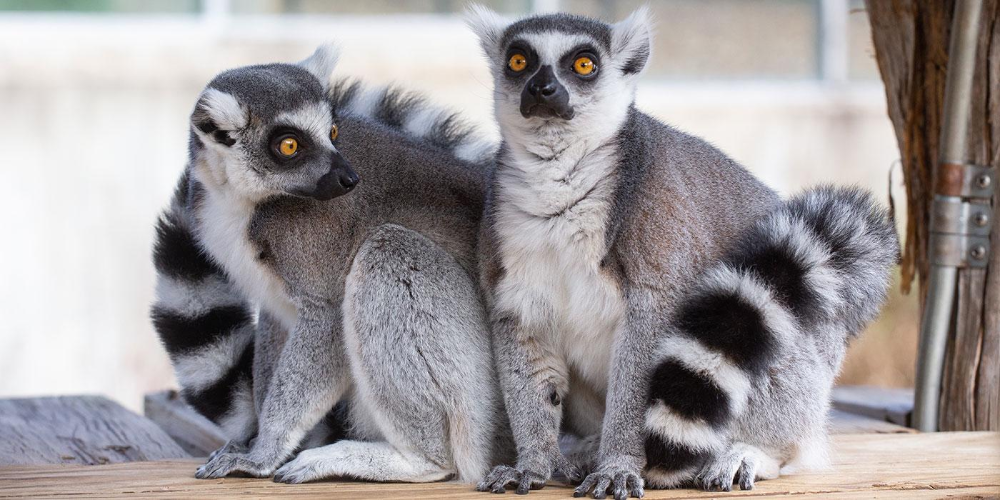The ring-tailed lemur (Lemur catta) is one of the most recognizable and iconic primates, known for its distinctive black and white ringed tail. Native to the island of Madagascar, these lemurs are a flagship species for conservation efforts and an emblem of Madagascar’s unique biodiversity. This article delves into the various aspects of the ring-tailed lemur’s biology, behavior, habitat, and conservation status, highlighting their significance in the animal kingdom and the challenges they face.
Physical Characteristics
Ring-tailed lemurs are medium-sized primates, weighing between 2.2 to 3.5 kilograms (5 to 7.7 pounds) with a body length of about 39 to 46 centimeters (15 to 18 inches) and a tail that can measure up to 56 centimeters (22 inches). Their fur is primarily gray or rosy brown, with white underparts and a distinct facial mask that includes black eye patches and a white face. The tail, used for balance and communication, is their most striking feature, adorned with alternating black and white rings.

Behavior and Social Structure
Ring-tailed lemurs are highly social animals, living in groups called troops that can range from 6 to 30 individuals. These troops are matriarchal, with females holding dominant positions over males. This social structure is relatively rare among primates and leads to interesting dynamics within the group.
Communication within the troop is achieved through a combination of vocalizations, scent marking, and body language. They have a variety of calls for different situations, such as alerting others to the presence of predators or maintaining group cohesion. Scent marking is crucial for defining territory and social status. Ring-tailed lemurs have specialized glands on their wrists and chests, which they use to mark their environment and convey information about their reproductive status and identity.
Diet and Foraging
Ring-tailed lemurs are omnivorous, with a diet that primarily consists of fruits, leaves, flowers, and bark. They have also been known to consume small vertebrates and insects on occasion. Their foraging behavior is highly adaptable, allowing them to exploit a variety of food sources depending on seasonal availability.
One of the key components of their diet is the tamarind tree (Tamarindus indica), whose fruits are a crucial food source during the dry season when other resources are scarce. The ability of ring-tailed lemurs to digest a wide range of plant materials is facilitated by their specialized gut microbiota, which helps in breaking down fibrous plant matter.
Habitat and Distribution
Ring-tailed lemurs are endemic to the southern and southwestern regions of Madagascar. They inhabit a variety of environments, including deciduous forests, spiny forests, and gallery forests along rivers. This adaptability to different habitats is one of the reasons they have managed to survive in the face of significant environmental changes.
Despite their adaptability, ring-tailed lemurs prefer areas with a combination of forest and open spaces, which provide both food and safety. During the day, they are often found foraging on the ground, but they retreat to the trees at night to avoid predators.
Reproduction and Lifespan
Breeding season for ring-tailed lemurs typically occurs from April to June, with births happening between August and September. Females usually give birth to a single offspring, although twins can occur occasionally. The gestation period lasts about 135 days.
Infants are highly dependent on their mothers for the first few weeks of life, clinging to their bellies before transitioning to riding on their backs. Weaning occurs at around five to six months, but young lemurs remain with their natal group for several years, learning essential survival and social skills.
In the wild, ring-tailed lemurs can live up to 18 years, though their lifespan can be longer in captivity, reaching up to 25 years or more.
Conservation Status and Threats
The ring-tailed lemur is currently classified as Endangered on the IUCN Red List. Their population has been declining rapidly due to a combination of factors, including habitat destruction, hunting, and the illegal pet trade.
Deforestation for agriculture, charcoal production, and human settlement is the primary threat to their habitat. Additionally, hunting for bushmeat and capture for the pet trade have significantly impacted their numbers. Conservation efforts are ongoing, with several protected areas established to preserve their habitat and reduce human-wildlife conflict.
Conservation Efforts
Various organizations and initiatives are working tirelessly to protect ring-tailed lemurs and also their habitat. Conservation strategies include habitat restoration, legal protection, community education, and ecotourism development. By involving local communities in conservation efforts and promoting sustainable land use practices, these initiatives aim to create a harmonious coexistence between humans and wildlife.
Research and monitoring are also crucial components of conservation. Studies on ring-tailed lemur behavior, ecology, and also genetics provide valuable insights that inform management strategies and help track population trends.
Conclusion
In conclusion, the ring-tailed lemur is a symbol of Madagascar’s extraordinary wildlife and the island’s ecological uniqueness. Their complex social structure, adaptability, and striking appearance make them a fascinating subject for scientific study and a priority for conservation. Protecting these remarkable primates requires a multifaceted approach, addressing both environmental and human factors. With continued efforts and global awareness, there is hope that the ring-tailed lemur will continue to thrive in the wild, preserving their place in Madagascar’s rich tapestry of life.









